Pea Protein Market by Type (Isolates, Concentrates and Textured), Application (Food, Beverages), Form (Dry, Wet), Source (Chickpeas, Yellow Split Peas, Lentils), Processing Method (Dry, Wet) and Region - Global Forecast to 2029
The pea protein market is estimated at USD 2.1 billion in 2024 and is projected to reach USD 3.7 billion by 2029, at a CAGR of 12.0% from 2024 to 2029.
As consumer priorities shift towards health and wellness, pea protein gains traction due to its association with various health benefits such as muscle building, weight management, and satiety support. This alignment with prevailing health trends drives demand among individuals seeking nutritious and functional food options. Pea protein's natural origin and minimal processing address consumers' preference for clean label products. Its incorporation in food formulations enables manufacturers to meet the demand for transparent ingredient lists, fostering trust and loyalty among discerning consumers.
The allergen-free nature of pea protein, devoid of common allergens like soy and dairy, makes it suitable for individuals with dietary restrictions or allergies. Its plant-based origin also aligns with the growing vegan and vegetarian lifestyle trends, further boosting its adoption in plant-based food and beverage products. In addition, the rising awareness of environmental sustainability prompts consumers to seek alternative protein sources with lower environmental footprints. Pea protein production's minimal resource requirements and reduced greenhouse gas emissions compared to animal-based proteins position it as an eco-conscious choice that resonates with environmentally aware consumers.
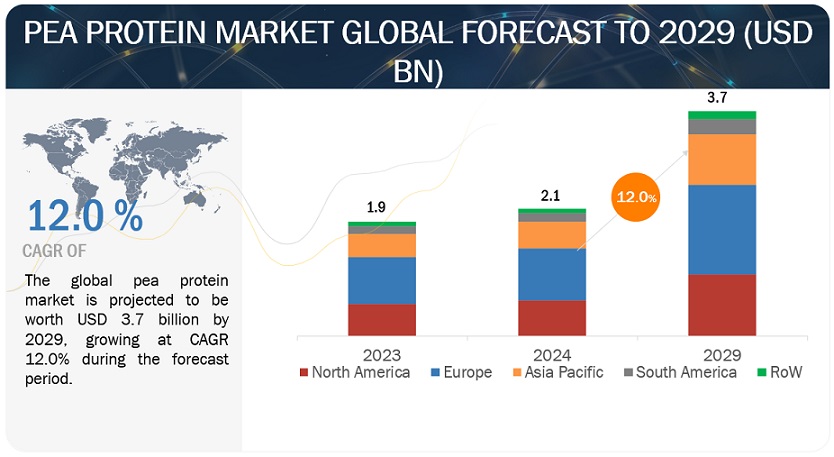
To know about the assumptions considered for the study, Request for Free Sample Report
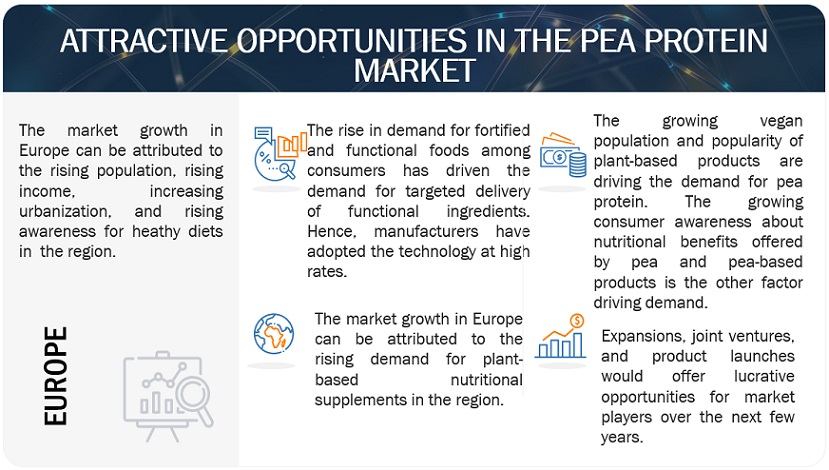
To know about the assumptions considered for the study, download the pdf brochure
Drivers: Growing consumer awareness about nutritional benefits offered by pea and pea-based products
In 2020, there was a significant rise in the popularity of plant-based foods globally, with various new products hitting the market, ranging from bakery items and pastries to pizza, lattes, and vegan burgers. By the end of the year, McDonald's joined the trend by introducing their McPlant menu. Additionally, the COVID-19 pandemic prompted two global lockdowns, leading people to reevaluate their priorities, focusing more on health and wellbeing. This shift resulted in a surge in plant-based food sales, increasing by 243%, with a notable 14% rise in the preference for meat-free and dairy-free options among consumers, as reported by New Food Magazine.
Pea protein powder has emerged as a popular ingredient for protein shakes, smoothies, and energy drinks due to its ability to enhance protein content. It is suitable for various dietary preferences as it is naturally vegan and hypoallergenic. Pea protein is rich in iron and high-quality protein, and it is believed to promote muscle growth, aid in weight loss, and support heart health. Studies indicate that protein derived from peas, particularly yellow peas, can help lower cholesterol and blood pressure without putting strain on the kidneys. These health benefits are anticipated to propel the growth of the global pea protein market.
Restraints: High cost of raw material
According to the October 2021 report by Roquette Frères, there has been a noticeable increase in global pea prices. The company, which launched a pea protein factory in Canada in 2020 and supplies to a prominent plant-based meat brand, "Beyond Meat," cautioned its customers about an imminent price surge. This warning came as the company observed a significant impact on supply from various fronts. Canada, a major pea-producing nation globally, experienced a sharp 45% decline in its production. Pea prices have surged by 120% compared to 2020 levels, following an unprecedented drought in Canada, described as the most severe in over a century.
Pea production in Europe, particularly in France, another significant pea-producing economy, also suffered as crops were severely damaged during harvest due to the wet season. Despite the growing global demand for peas driven by the introduction of numerous new plant-based food products, the sector is grappling with the repercussions of a pea shortage. The substantial price hikes are expected to result in increased costs for customers as companies look to offset rising expenses. Consequently, the market faces constraints on growth due to the unstable supply of raw materials and escalating prices.
Opportunities: Increasing focus on innovation and developments of better pea protein extracts & products in global markets
With evolving lifestyles and growing consumer demand for diverse options, the pea protein sector is experiencing a surge in innovation. Currently, pea protein serves as a primary ingredient in numerous plant-based meat products, including energy bars and snacks. Food technology companies are diligently refining this ingredient at every stage of production to cater to plant-based meat manufacturers, ranging from optimizing pea cultivation in the field to refining protein extraction technology.
Many consumers prioritize maximum protein content when selecting products, prompting companies to strive for higher protein extraction rates from raw materials to incorporate into their end products. In October 2021, Benson Hill, a company based in Missouri, launched a new yellow pea breeding and commercialization program aimed at developing plants that yield superior peas. Their focus lies on enhancing two critical attributes: nutritional density and flavor. The cultivation of more protein-rich yellow pea plants could also lead to greater efficiency in land use in farming practices. Benson Hill leverages a machine learning and AI-powered platform to guide its efforts in crop improvement.
On 2022, merit Functional Foods (Canada) opened a 94,000 square foot plant to process pea and canola protein. The company uses a proprietary manufacturing process that is more expensive than the industry standard. The process requires more equipment and more filtration but results in a higher-purity product with improved taste and texture. According to StartUs Insights (an AI-powered data platform), in September 2021, 149 new startups were identified in the pea protein sector, with the top five being Sunfed Food (New Zealand) (makes meat alternatives), Mighty Pea (UK) (formulates vegan milk), Elevate Nutrition (US) (offers sports nutrition), YoFiit (Canada) (offers plant-based nutrition bars), and PeaTos (US) (produces pea-based snacks). Thus, with a greater number of startups rising in the sector, significant research is being taken up to develop newer attractive products in the market.
Challenges: Supply constraints due to unstable production of peas hampering growth prospects
Pea protein manufacturers are confronted with a significant challenge: a shortage in supply. Climate change is already impacting agriculture, with consequences varying across regions. Rising temperatures have begun to diminish the yields of essential crops. Reduced production, compounded by import delays due to COVID-19, has resulted in escalated pea prices. According to an article by IndiaToday, the cost of pulses, which serve as one of the most affordable protein sources, has surged by over 15% since the previous year.
The USDA forecasts a 3% decline in the area seeded to dry peas in the US for 2021-22 compared to 2020, dropping to below 1.0 million acres, primarily driven by decreased seeding in North Dakota. Yields are anticipated to be below average. The USDA further projects a 44% decrease in US dry pea production to slightly over 0.5 million metric tons. Consequently, this decrease in production leads to fluctuations in prices and market uncertainty, posing significant challenges for both manufacturers and consumers in the global pea protein market.
Market Ecosystem
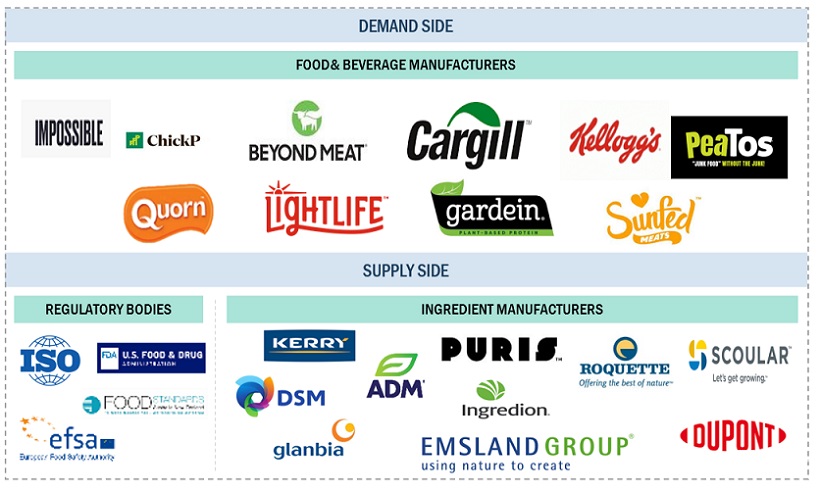
Based on the form, dry is estimated to account for the largest market share of the pea protein market.
Dry pea protein's powdered form streamlines formulation processes, ensuring precise measurement and consistent distribution throughout food and beverage products. This consistency in formulation maintains product quality, meeting consumer expectations for reliable and enjoyable products. Additionally, the reduced moisture content of dry pea protein translates to lighter weight and reduced volume, lowering transportation costs for both manufacturers and consumers. This cost-saving benefit contributes to the widespread adoption of dry pea protein across various markets.
The longer shelf life of dry pea protein minimizes the risk of spoilage and reduces food waste. This extended shelf life enhances product stability, ensuring prolonged availability to consumers and driving further demand for dry pea protein.
Based on source, yellow split peas is anticipated to have the highest growth rate in the pea protein market.
Yellow split peas serve as a significant driver in the pea protein market for several reasons. Their abundant protein content makes them an ideal source for pea protein extraction, enhancing the nutritional value of pea protein products. This appeals to consumers seeking protein-rich foods, especially within plant-based diets. The versatility of yellow split peas in food applications extends from soups and salads to baked goods, facilitating the creation of a diverse range of pea protein-based foods. This flexibility allows manufacturers to cater to various consumer preferences, including plant-based meats, dairy alternatives, snacks, and supplements.
Furthermore, yellow split peas are a sustainable crop choice, requiring fewer resources such as water and land compared to animal-based protein sources. Their ability to fix nitrogen in the soil reduces the need for synthetic fertilizers, aligning with consumer preferences for eco-friendly and ethically sourced products. The rising popularity of plant-based diets, driven by concerns for health, animal welfare, and environmental sustainability, fuels the demand for pea protein derived from yellow split peas. As more individuals adopt vegetarian, vegan, or flexitarian lifestyles, the demand for plant-based protein sources like pea protein continues to grow, positioning yellow split peas as a key driver in the pea protein market.
The European market is projected to contribute the largest share of the global pea protein processing market.
The Europe region is witnessing a burgeoning wave of growth in the pea protein market as food & beverage industries across the continent embrace the multifunctional applications of this plant based compound. European region's active participation in global trade further amplifies the accessibility of pea protein. The ease of trade facilitates the flow of these versatile compounds across borders, supporting the region's industries with a diverse range of applications.
European countries are active participants in global trade, both as importers of raw materials and exporters of finished products. The demand for pea protein in Europe influences international trade dynamics, affecting production, pricing, and supply chains globally. Europe has been at the forefront of environmental awareness and sustainability initiatives. The increasing awareness of environmental sustainability prompts consumers to seek alternative protein sources with lower environmental footprints. Pea protein production requires fewer natural resources and emits fewer greenhouse gases compared to animal-based proteins, making it an environmentally friendly choice that resonates with eco-conscious consumers.
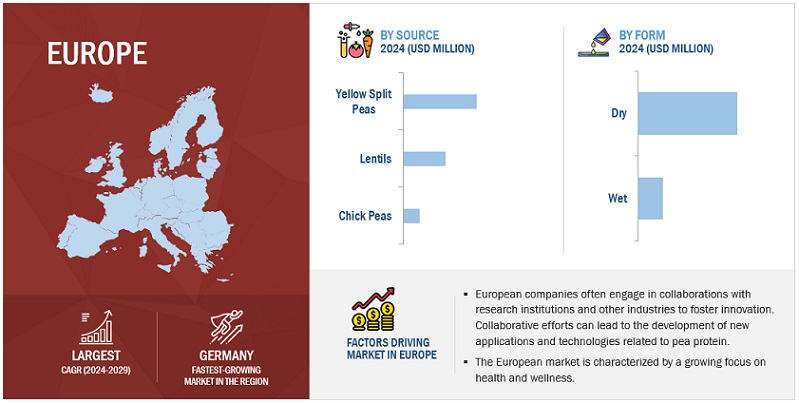
Key Market Players
Key players operating in the pea protein market include Roquette Frères (France), Cargill, Incorporated (US), Glanbia PLC (Ireland), Kerry (Ireland), Ingredion Incorporated (US), Emsland Group (Germany), Yantai Shuangta Foods Co, Ltd (China), The Scoular Company (US), Burcan Nutrascience Corp (Canada), Shandong Jianyuan Group (China), ET-Chem (China), AGT Foods and Ingredients (Canada), The Green Labs LLC (US) and Axiom Foods Inc (US). These players in this market are focusing on increasing their presence through expansion and collaboration. These companies have a strong presence in North America, Asia Pacific, and Europe.
Get online access to the report on the World's First Market Intelligence Cloud
- Easy to Download Historical Data & Forecast Numbers
- Company Analysis Dashboard for high growth potential opportunities
- Research Analyst Access for customization & queries
- Competitor Analysis with Interactive dashboard
- Latest News, Updates & Trend analysis
Request Sample Scope of the Report
Get online access to the report on the World's First Market Intelligence Cloud
- Easy to Download Historical Data & Forecast Numbers
- Company Analysis Dashboard for high growth potential opportunities
- Research Analyst Access for customization & queries
- Competitor Analysis with Interactive dashboard
- Latest News, Updates & Trend analysis
|
Report Metric |
Details |
|
Market size estimation |
2024–2029 |
|
Base year considered |
2023 |
|
Forecast period considered |
2024–2029 |
|
Units considered |
Value (USD Million), Volume (TONS) |
|
Segments Covered |
By Type, By Application, By Form, By Source, By Processing Method and By Region |
|
Regions covered |
North America, Europe, Asia Pacific, and Rest of the World |
|
Companies studied |
Roquette Frères (France) |
Pea protein Market:
By Type
- Isolates
- Concentrates
- Textured
By Application
- Food
- Beverage
- Other Applications
By Form
- Dry
- Wet
By Source
- Chickpeas
- Yellow Split Peas
- Lentils
By Processing Method
- Dry processing method
- Wet processing method
By Region
- North America
- Europe
- Asia Pacific
- Rest of the World (RoW)
Recent Developments
- In June 2020, Roquette Frères has joined a collaborative R&D initiative to promote Canada's plant protein ecosystem, identify solutions to development issues in cold Prairie conditions, and develop novel pea and fava bean products. The total investment by these three companies was USD 19.2 million. This collaboration will address the present pea processing issue and will help to implant new technology in pea protein processing.
- In November 2022, Ingredion Incorporated has entered an exclusive commercial distribution partnership with InnovoPro, a prominent chickpea solutions company. This partnership, effective immediately, focuses on distributing chickpea protein concentrate in the US and Canada. The aim is to enhance the availability of chickpea protein, aiding food and beverage manufacturers in meeting the rising consumer demand for sustainable, nutritious, and appealing plant-based products.
Frequently Asked Questions (FAQ):
Which region is projected to account for the largest share of the pea protein market?
The Europe region accounted for the largest share in terms of value at USD 0.8 billion in 2024 and is expected to grow at a CAGR of 11.7% during the forecast period.
What is the current size of the global pea protein market?
The pea protein market is estimated at USD 2.1 billion in 2024 and is projected to reach USD 3.7 billion by 2029, at a CAGR of 12.0% from 2024 to 2029.
Which are the major key players in the pea protein market?
Roquette Frères (France), Cargill, Incorporated (US), Glanbia PLC (Ireland), Kerry (Ireland), Ingredion Incorporated (US), Emsland Group (Germany), Yantai Shuangta Foods Co, Ltd (China), The Scoular Company (US), Burcan Nutrascience Corp (Canada), Shandong Jianyuan Group (China), ET-Chem (China), AGT Foods and Ingredients (Canada), The Green Labs LLC (US) and Axiom Foods Inc (US).
What are the factors driving the pea protein market?
- Nutritional Value: Pea protein boasts high protein content, ideal for health-conscious consumers seeking nutrient-rich alternatives.
- Allergen-Free: Its absence of soy, dairy, and gluten caters to individuals with dietary restrictions, ensuring broader accessibility and appeal in the market.
- Sustainability: Pea protein's cultivation requires fewer resources and emits fewer greenhouse gases than animal-based proteins, making it an environmentally friendly choice.
- Versatility: With its neutral flavor and functional properties, pea protein seamlessly integrates into various food and beverage applications, enhancing product innovation and consumer choice.
- Plant-Based Trend: As plant-based diets gain traction, pea protein emerges as a favored option, aligning with the growing consumer preference for sustainable and ethical food choices.
Which segment by source accounted for the largest pea protein market share?
By source, the yellow split pea segment dominated the market for pea protein and was valued the largest at USD 1.1 billion in 2024. .
To speak to our analyst for a discussion on the above findings, click Speak to Analyst
The research study involved extensive secondary sources, directories, and databases such as Bloomberg Businessweek and Factiva to identify and collect information useful for a technical, market-oriented, and commercial study of the pea protein market. In-depth interviews were conducted with various primary respondents—such as key industry participants, subject matter experts (SMEs), C-level executives of key market players, and industry consultants—to obtain and verify critical qualitative and quantitative information and assess prospects.
Secondary Research
The secondary sources referred for this research study include government sources, such as the Food and Agriculture Organization (FAO), the US Department of Agriculture (USDA), Eurostat (EU Database), and various national ministries of the agricultural department, corporate filings (such as annual reports, press releases, investor presentations, and financial statements), and trade, business, and professional associations such as In the secondary research process, various organizations such as the Saskatchewan Pulse Growers (Saskpulse), Good Food Institute (GFI), and European Vegetable Protein Association (EUVEPRO), were referred to identify and collect information for this study.
Secondary research was mainly used to obtain key information about the industry's supply chain—the total pool of key players, market classification, and segmentation according to the industry trends and key developments from market-oriented perspectives.
Primary Research
The pea protein market comprises several stakeholders, including raw material suppliers, ingredient suppliers, end-product manufacturers, and regulatory organizations in the supply chain. Various primary sources from both the supply and demand sides of the market were interviewed to obtain qualitative and quantitative information. Primary interviewees from the supply side include research institutions involved in R&D to introduce technology, distributors, wholesalers, importers & exporters of processed ingredients manufacturers and technology providers. Primary sources from the demand-side include key opinion leaders, executives, vice presidents, and CEOs through questionnaires, emails, and telephonic interviews.
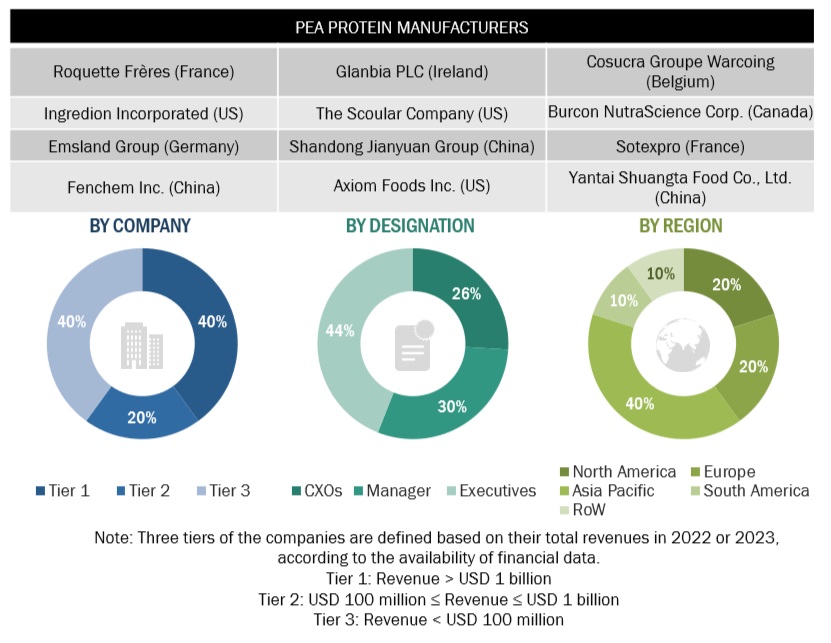
To know about the assumptions considered for the study, download the pdf brochure
Market Size Estimation
Both the top-down and bottom-up approaches have been used to estimate and validate the total size of the pea protein market. These approaches were extensive to determine the size of the subsegments in the market. The research methodology used to estimate the market size includes the following details:
-
Top-down approach:
- The key players in the industry and the market were identified through extensive secondary research.
- The industry's supply chain and market size were determined through primary and secondary research.
- All percentage share splits and breakdowns were determined using secondary sources and verified through primary sources.
- The parent market—the pea processed ingredients market—was considered to validate pea protein's market details further.
-
Bottom-up approach:
- The market sizes were analyzed based on each type of pea protein share at regional and country levels. Thus, the global market for pea protein was estimated with a bottom-up approach of the type at the country level.
- Based on the demand for the mode of application, offerings of key players, and the region-wise market share of major players, the global market for the mode of application was estimated.
- Other factors considered include penetration rate of pea protein in end-user applications such as meat substitutes, performance nutrition, and functional foods, consumer awareness, and function trends, pricing trends, the adoption rate and price factors, patents registered, and organic and inorganic growth attempts.
- All macroeconomic and microeconomic factors affecting the growth of the pea protein market were considered while estimating the market size.
- All possible parameters that affect the market covered in this research study were accounted for, viewed in extensive detail, verified through primary research, and analyzed to obtain final quantitative and qualitative data.
Market size estimation: Top-Down approach
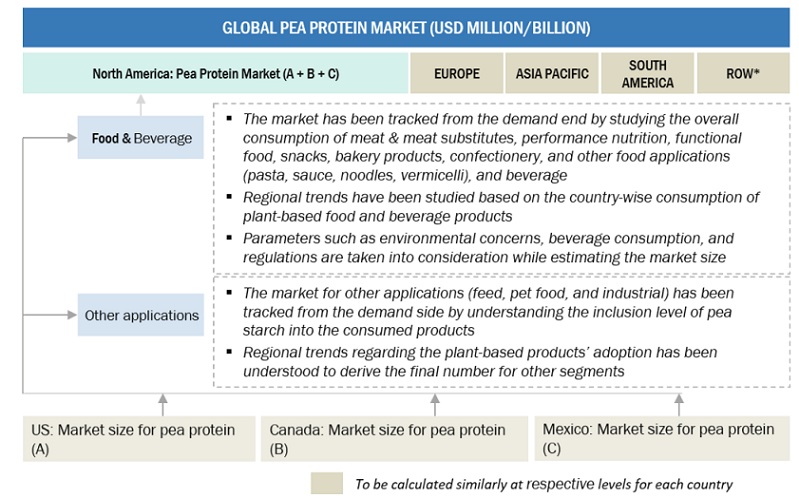
To know about the assumptions considered for the study, Request for Free Sample Report
Market size estimation methodology: Bottom-up approach
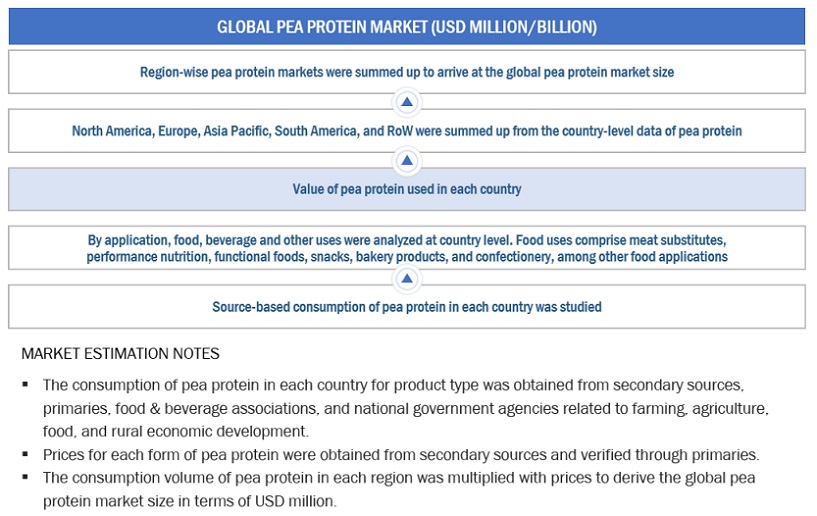
Data Triangulation
After arriving at the overall market size from the estimation process explained above, the total market was split into several segments and subsegments. The data triangulation and market breakdown procedures were employed, wherever applicable, to estimate the overall pea protein market and arrive at the exact statistics for all segments and subsegments. The data was triangulated by studying various factors and trends from the demand and supply sides. Along with this, the market size was validated using both the top-down and bottom-up approaches.
Market Definition
Pea protein is a vegetable protein with a neutral taste derived from different pea types such as chickpeas, yellow peas, lentils, and beans. It is produced as isolates, concentrated, and textured proteins and is highly nutritious. Pea protein is considered vegan and is not classified as a major allergen. Therefore, it is suitable for consumption for a wider consumer base. Pea protein also has a well-maintained amino acid profile and features high solubility and low viscosity, which add to its nutritional value.
Pea proteins can be used in various applications, including performance nutrition, bakery products, snack bars, beverages, meat alternatives, and dairy alternatives.
Key Stakeholders
- Food manufacturers
- Meat alternative manufacturers
- Dairy alternative manufacturers
- Sports nutrition manufacturers
- Food importers and exporters
- Intermediary suppliers include traders and distributors of plant-based sources such as soy, pea, corn, chia, and flax.
- Government and research organizations
-
Associations and industry bodies:
- Food and Agriculture Organization (FAO)
- United States Department of Agriculture (USDA)
- European Food Safety Authority (EFSA)
- European Association of Specialty Feed Ingredients and their Mixtures (FEFANA)
- Organization for Economic Co-operation and Development (OECD)
- Venture capitalists and investors
Report Objectives
Market Intelligence
- To determine and project the size of the pea protein market by source, type, application, form, and region over five years, ranging from 2024 to 2029.
- To identify attractive opportunities in the market by determining the largest and fastest-growing segments across regions.
-
To analyze the demand-side factors based on the following:
- Impact of macro and microeconomic factors on the market.
- Shifts in demand patterns across different subsegments and regions.
- To recognize the key drivers and restraints impacting the global pea protein market.
Competitive Intelligence
- To profile the key players of the pea protein market and comprehensively analyze their market positions and core competencies
-
To provide a comparative analysis of the market leaders based on the following:
- Product offerings
- Business strategies
- Strengths, weaknesses, opportunities, and threats
- Key financials
- To understand the competitive landscape and identify the major growth strategies adopted by players across the key regions
- To provide insights on the key investments in product innovations and patent registrations
Available Customizations:
With the given market data, MarketsandMarkets offers customizations according to company-specific scientific needs.
The following customization options are available for the report:
Product Analysis
- Product Matrix, which gives a detailed comparison of the product portfolio of each company.
Geographic Analysis
With the given market data, MarketsandMarkets offers customizations according to company-specific scientific needs.
- Further breakdown of the Rest of European pea protein market, by key country
- Further breakdown of the Rest of the South American pea protein market, by key country
- Further breakdown of the Rest of Asia Pacific pea protein market, by key country
Company Information
- Detailed analyses and profiling of additional market players


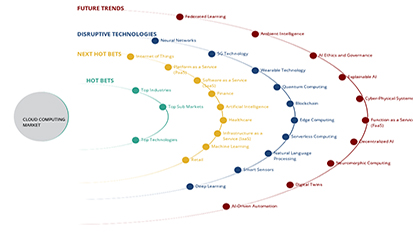

 Generating Response ...
Generating Response ...







Growth opportunities and latent adjacency in Pea Protein Market